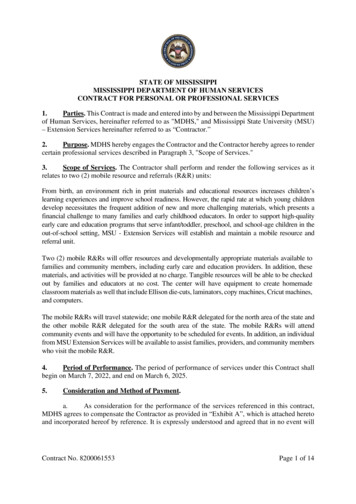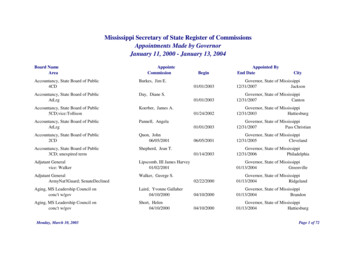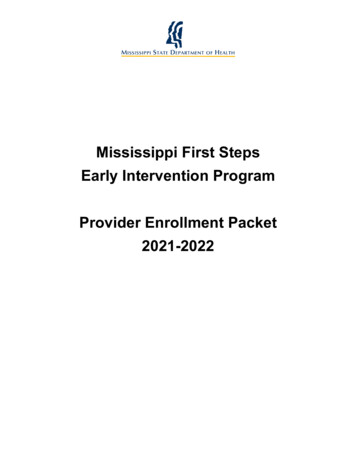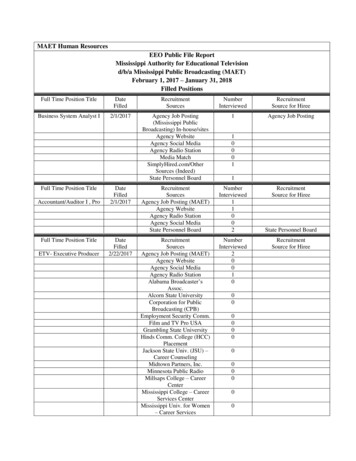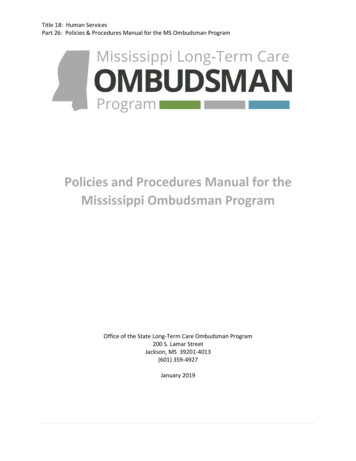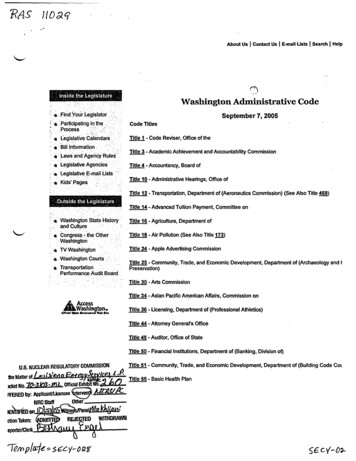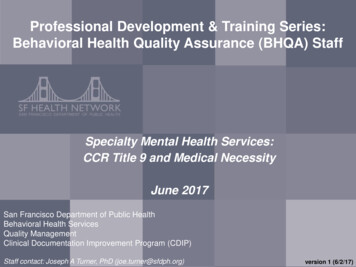
Transcription
Title 15: Mississippi State Department of HealthPart 21: Division of Radiological HealthSubpart 78: Radiological HealthChapter 1REGULATIONS FOR CONTROL OF RADIATION IN MISSISSIPPISubchapter 1General ProvisionsRule 1.1.1Scope. Except as otherwise specifically provided, these regulations apply to allpersons who receive, possess, use, transfer, own, or acquire any source ofradiation; provided, however, that nothing in these regulations shall apply to anyperson to the extent such person is subject to regulation by the U.S. NuclearRegulatory Commission.1SOURCE: Miss. Code Ann. §45-14-11Rule 1.1.21Definitions. As used in these regulations, these terms have the definitions setforth below. Additional definitions used only in a certain section will be foundin that section.1."A1" means the maximum activity of special form radioactive material permittedin a Type A package. "A2" means the maximum activity of radioactive material,other than special form, LSA and SCO material, permitted in a Type A package.These values are either listed in Appendix A, Table A-1 of Subchapter 13 ofthese regulations or may be derived in accordance with the procedureprescribed in Appendix A of Subchapter 13 of these regulations.2."Absorbed dose" means the energy imparted to matter by ionizing radiation perunit mass of irradiated material at the place of interest. The units of absorbeddose are the rad and the gray (Gy).3."Accelerator" means any machine capable of accelerating electrons, protons,deuterons, or other charged particles in a vacuum and of discharging theresultant particulate or other radiation into a medium at energies usually inexcess of 1 MeV. For purposes of this definition, "particle accelerator" is anequivalent term.4."Accelerator-produced radioactive material" means any material maderadioactive by a particle accelerator.5.“Acute” as used in this part, means a single radiation dose or multipleradiation dose occurring within a short time (24 hours or less).6."Act" means the Mississippi Radiation Protection Law of 1976.Attention is directed to the fact that regulation by the State of source material, byproduct material, and specialnuclear material in quantities not sufficient to form a critical mass is subject to the provisions of the agreementbetween State and the U.S. Nuclear Regulatory Commission and to 10 CFR Part 150 of the Commission’sregulations.
7."Activity" means the rate of disintegration (transformation) or decay ofradioactive material. The units of activity are the curie (Ci) and the becquerel(Bq).8."Adult" means an individual 18 or more years of age.9."Agency" means the Mississippi State Department of Health.10."Agreement State" means any State with which the U.S. Nuclear RegulatoryCommission or the U.S. Atomic Energy Commission has entered into an effectiveagreement under Subchapter 274b. of the Atomic Energy Act of 1954, as amended(73 Stat. 689).11."Airborne radioactive material" means any radioactive material dispersed in the airin the form of dusts, fumes, particulates, mists, vapors, or gases.12."Airborne radioactivity area" means a room, enclosure, or area in which airborneradioactive materials exist in concentrations:a. in excess of the derived air concentrations (DACs) specified in Subchapter 4(10 CFR Part 20, Appendix B, Table 1) of these regulations; orb. to such a degree that an individual present in the area without respiratoryprotective equipment could exceed, during the hours an individual is present ina week, an intake of 0.6 percent of the annual limit on intake (ALI) or 12 DAChours.13."Alert" means events may occur, are in progress, or have occurred that could leadto a release of radioactive material but that the release is not expected to require aresponse by offsite response organizations to protect persons offsite.14."As low as is reasonably achievable" (ALARA) means making every reasonableeffort to maintain exposures to radiation as far below the dose limits in theseregulations as is practical, consistent with the purpose for which the licensed orregistered activity is undertaken, taking into account the state of technology, theeconomics of improvements in relation to state of technology, the economics ofimprovements in relation to benefits to the public health and safety, and othersocietal and socioeconomic considerations, and in relation to utilization of nuclearenergy and licensed or registered sources of radiation in the public interest.15."Becquerel" (Bq) means the SI unit of activity. One becquerel is equal to 1disintegration or transformation per second (dps or tps).16."Bioassay" means the determination of kinds, quantities or concentrations, and, insome cases, the locations of radioactive material in the human body, whether bydirect measurement, in vivo counting, or by analysis and evaluation of materialsexcreted or removed from the human body. For purposes of these regulations,"radiobioassay" is an equivalent term.17."Brachytherapy" means a method of radiation therapy in which sealed sources areutilized to deliver a radiation dose at a distance of up to a few centimeters, bysurface, intracavitary, or interstitial application.
18."Byproduct material" means:a. Any radioactive material, except special nuclear material, yielded in or maderadioactive by exposure to the radiation incident to the process of producingor utilizing special nuclear material;b. The tailings or wastes produced by the extraction or concentration of uraniumor thorium from ore processed primarily for its source material content,including discrete surface wastes resulting from uranium solution extractionprocesses. Underground ore bodies depleted by these solution extractionoperations do not constitute "byproduct material" within this definition;c. Any discrete source of radium-226 that is produced, extracted, or convertedafter extraction, for use for a commercial, medical, or research activity;d. Any material that has been made radioactive by use of a particle accelerator;and is produced, extracted, or converted after extraction, for use for acommercial, medical, or research activity; ande. Any discrete source of naturally occurring radioactive material, other thansource material, that the Nuclear Regulatory Commission, in consultation withthe Administrator of the Environmental Protection Agency, the Secretary ofEnergy, the Secretary of Homeland Security, and the head of any otherappropriate Federal agency, determines would pose a threat similar to thethreat posed by a discrete source of radium-226 to the public health and safetyor the common defense and security; and is extracted or converted afterextraction for use in a commercial, medical, or research activity.19."Calendar quarter" means not less than 12 consecutive weeks nor more than 14consecutive weeks. The first calendar quarter of each year shall begin in Januaryand subsequent calendar quarters shall be so arranged such that no day is includedin more than one calendar quarter and no day in any one year is omitted frominclusion within a calendar quarter. No licensee or registrant shall change themethod observed by him of determining calendar quarters for purposes of theseregulations except at the beginning of a year.20."Calibration" means the determination of (1) the response or reading of aninstrument relative to a series of known radiation values over the range of theinstrument, or (2) the strength of a source of radiation relative to a standard.21."CFR" means Code of Federal Regulations”22."Chelating agent" means amine polycarboxylic acids, hydroxycarboxylic acids,gluconic acid, and polycarboxylic acids.23."Collective dose" means the sum of the individual doses received in a given periodof time by a specified population from exposure to a specified source of radiation.24."Committed dose equivalent" (HT,50) means the dose equivalent to organs ortissues of reference (T) that will be received from an intake of radioactive materialby an individual during the 50-year period following the intake. "Committed
effective dose equivalent" (HE, 50) is the sum of the products of the weighting factorsapplicable to each of the body organs or tissues that are irradiated and thecommitted dose equivalent to each of these organs or tissues (HE,50 Σ wTHT,50).25.“Consortium” means an association of medical use licensees and a PETradionuclide production facility in the same geographical area that jointly own orshare in the operation and maintenance cost of the PET radionuclide productionfacility that produces PET radionuclides for use in producing radioactive drugswithin the consortium for noncommercial distributions among its associatedmembers for medical use. The PET radionuclide production facility within theconsortium must be located at an educational institution or a Federal facility or amedical facility.26."Controlled area" means an area, outside of a restricted area but inside the siteboundary, access to which can be limited by the licensee or registrant for anyreason.27.“Critical Group” means the group of individuals reasonably expected to receive thegreatest exposure to residual radioactivity for any applicable set of circumstances.28."Curie" means a unit of quantity of radioactivity. One curie (Ci) is that quantity ofradioactive material which decays at the rate of 3.7E 10 transformations per second(tps). Commonly used submultiples of the curie are the millicurie and themicrocurie. One millicurie (mCi) 0.001 curie 3.7E 7 tps. One microcurie (Ci) 0.000001 curie 3.7E 4 tps (See 1.1.16 for SI equivalent becquerel).29."Decommission" means to remove a facility or site safely from service and reduceresidual radioactivity to a level that permits:a. Release of the property for unrestricted use and termination of the license; orb. Release of the property under restricted conditions and termination of thelicense.30."Deep dose equivalent" (Hd), which applies to external whole body exposure,means the dose equivalent at a tissue depth of 1 centimeter (1000 mg/cm2).31."Depleted uranium" means the source material uranium in which the isotopeuranium-235 is less than 0.711 weight percent of the total uranium present. Depleteduranium does not include special nuclear material.32.“Discrete source” means a radionuclide that has been processed so that itsconcentration within a material has been purposely increased for use forcommercial, medical, or research activities.33.“Distinguishable from background” means that the detectable concentration of aradionuclide is statistically different from the background concentration of thatradionuclide in the vicinity of the site or, in the case of structures, in similarmaterials using adequate measurements technology, survey, and statisticaltechniques.34."Dose" is a generic term that means absorbed dose, dose equivalent, effective doseequivalent, committed dose equivalent, committed effective dose equivalent, total
organ dose equivalent, or total effective dose equivalent. For purposes of theseregulations, "radiation dose" is an equivalent term.35.“Dose Commitment” means the total radiation dose to a part of the body that willresult from retention in the body of radioactive material. For purposes of estimatingthe dose commitment, it is assumed that from the time of intake the period ofexposure to retained material will not exceed 50 years.36."Dose equivalent (HT)" means the product of the absorbed dose in tissue, qualityfactor, and all other necessary modifying factors at the location of interest. Theunits of dose equivalent are the rem and the sievert (Sv).37."Dose limits" means the permissible upper bounds of radiation doses established inaccordance with these regulations. For purposes of these regulations, "limits" is anequivalent term.38."Effective dose equivalent (HE)" means the sum of the products of the doseequivalent to each organ or tissue (HT) and the weighting factor (wT) applicable toeach of the body organs or tissues that are irradiated (HE Σ wTHT).39."Embryo/fetus" means the developing human organism from conception until thetime of birth.40."Entrance or access point" means any opening through which an individual orextremity of an individual could gain access to radiation areas or to sources ofradiation. This includes entry or exit portals of sufficient size to permit humanentry, irrespective of their intended use.41."Explosive material" means any chemical compound, mixture, or device whichproduces a substantial instantaneous release of gas and heat spontaneously or bycontact with sparks or flame.42."Exposure" means being exposed to ionizing radiation or to radioactive material.43."Exposure" means the quotient of dQ by dm where "dQ" is the absolute value ofthe total charge of the ions of one sign produced in air when all the electrons(negatrons and positrons) liberated by photons in a volume element of air havingmass "dm" are completely stopped in air. The SI unit of exposure is the coulombper kilogram (C/kg). The special unit of exposure is the roentgen (R) (See 1.1.15for SI equivalent coulomb per kilogram).22"When not underlined as above or indicated as 'exposure' (x), the term 'exposure' has amore general meaning in these regulations."44."Exposure rate" means the exposure per unit of time, such as roentgen per minuteand milliroentgen per hour.45."External dose" means that portion of the dose equivalent received from any sourceof radiation outside the body.46."Extremity" means hand, elbow, arm below the elbow, foot, knee, and leg belowthe knee.
47."Former U.S. Atomic Energy Commission (AEC) or U.S. Nuclear RegulatoryCommission (NRC) licensed facilities" means nuclear reactors, nuclear fuelreprocessing plants, uranium enrichment plants, or critical mass experimentalfacilities where AEC or NRC licenses have been terminated.48."Generally applicable environmental radiation standards" means standards issuedby the U.S. Environmental Protection Agency (EPA) under the authority of theAtomic Energy Act of 1954, as amended, that impose limits on radiation exposuresor levels, or concentrations or quantities of radioactive material, in the generalenvironment outside the boundaries of locations under the control of personspossessing or using radioactive material.49."Gray" (Gy) means the SI unit of absorbed dose. One gray is equal to an absorbeddose of 1 joule per kilogram (100 rads).50."Hazardous waste" means those wastes designated as hazardous by the U.S.Environmental Protection Agency regulations in 40 CFR Part 261.51."Healing arts" means the professional disciplines authorized by the laws of thisstate to use sources of radiation in the diagnosis or treatment of human or animaldiseases.52."High radiation area" means an area, accessible to individuals, in which radiationlevels from radiation sources external to the body could result in an individualreceiving a dose equivalent in excess of 0.1 rem (1 millisievert) in 1 hour at 30centimeters from any source of radiation or 30 centimeters from any surface thatthe radiation penetrates.53."Human use" means the internal or external administration of radiation orradioactive material to human beings.54."Individual" means any human being.55."Individual monitoring" means the assessment of:a. Dose equivalent: (a) by the use of individual monitoring devices, or (b) by theuse of survey data; orb. Committed effective dose equivalent: (a) by bioassay, or (b) by determinationof the time-weighted air concentrations to which an individual has beenexposed, that is, DAC-hours.(See the definition of DAC-hours inSubchapter 4).56."Individual monitoring devices" (individual monitoring equipment) means devicesdesigned to be worn by a single individual for the assessment of dose equivalentsuch as film badges, thermoluminescence dosimeters (TLDs), optically stimulatedluminescence dosimeters (OSLs), pocket ionization chambers, and personal(“lapel”) air sampling devices
57."Inspection" means an official examination or observation including, but notlimited to, tests, surveys, and monitoring to determine compliance with rules,regulations, orders, requirements, and conditions of the Agency.58."Interlock" means a device arranged or connected such that the occurrence of anevent or condition is required before a second event or condition can occur orcontinue to occur.59."Internal dose" means that portion of the dose equivalent received from radioactivematerial taken into the body60.“Lens dose equivalent” (LDE) applies to the external exposure of the lens of theeye and is taken as the dose equivalent at a tissue depth of 0.3 centimeter (300mg/cm2).61."License" means a license issued by the Agency in accordance with the regulationsadopted by the Agency.62."Licensed material" means radioactive material received, possessed, used,transferred or disposed of under a general or specific license issued by the Agency.63."Licensee" means any person who is licensed by the Agency in accordance withthese regulations and the Act.64."Licensing State" means any State with regulations equivalent to the SuggestedState Regulations for Control of Radiation relating to, and an effective program for,the regulatory control of NARM and which has been granted final designation bythe Conference of Radiation Control Program Directors, Inc.65."Limits" See "Dose limits".66."Lost or missing source of radiation" means a source of radiation whose location isunknown. This definition includes licensed material that has been shipped but hasnot reached its planned destination and whose location cannot be readily traced inthe transportation system.67.“Lot Tolerance Percent Defective” means the poorest quality in an individualinspection lot that should be accepted, expressed in percent defective.68."Major processor" means a user processing, handling, or manufacturing radioactivematerial exceeding Type A quantities as unsealed sources or material, or exceeding4 times Type B quantities as sealed sources, but does not include nuclear medicineprograms, universities, industrial radiographers, or small industrial programs. TypeA and B quantities are defined in Subchapter 13 (10 CFR 71.4) of these regulations.69."Member of the public" means any individual except when that individual isreceiving an occupational dose.70."Minor" means an individual less than 18 years of age.71."NARM" means any naturally occurring or accelerator-produced radioactivematerial. It does not include byproduct, source, or special nuclear material.
72.“Nationally tracked source” means a sealed source containing a quantity equal toor greater than Category 1 or Category 2 levels of any radioactive material listed inSubchapter 4 (10 CFR Part 20, Appendix E) of these regulations. In this context asealed source is defined as radioactive material that is sealed in a capsule or closelybonded, in a solid form and which is not exempt from regulatory control. It doesnot mean material encapsulated solely for disposal, or nuclear material containedin any fuel assembly, subassembly, fuel rod, or fuel pellet. Category 1 nationallytracked sources are those containing radioactive material at a quantity equal to orgreater than the Category 1 threshold. Category 2 nationally tracked sources arethose containing radioactive material at a quantity equal to or greater than theCategory 2 threshold but less than the Category 1 threshold.73."Natural radioactivity" means radioactivity of naturally occurring nuclides.74."Nuclear Regulatory Commission" (NRC) means the U.S. Nuclear RegulatoryCommission or its duly authorized representatives.75."Occupational dose" means the dose received by an individual in the course ofemployment in which the individual's assigned duties involve exposure to radiationand/or radioactive material from licensed and unlicensed sources of radiation,whether in the possession of the licensee, registrant, or other person. Occupationaldose does not include doses from background radiation, from any medicaladministration the individual has received, from exposure to individualsadministered radioactive material and released in accordance with Subchapter 7 (10CFR 35.75) of these regulations, from voluntary participation in medical researchprograms, or as a member of the public.76.“Offshore Waters” means that area of land and water, beyond Agreement States'Submerged Lands Act jurisdiction, on or above the U.S. Outer Continental Shelf.77."Package" means the packaging together with its radioactive contents as presentedfor transport.78."Particle accelerator" See "Accelerator".79."Person" means any individual, corporation, partnership, firm, association, trust,estate, public or private institution, group, agency, political subdivision of this State,any other State or political subdivision or agency thereof, and any legal successor,representative, agent, or agency of the foregoing, other than the NRC and federalgovernment agencies licensed or exempted by the NRC.80."Personnel monitoring equipment" See "Individual monitoring devices".81."Pharmacist" means an individual licensed by this State to compound and dispensedrugs, prescriptions, and poisons.82."Physician" means an individual licensed by this State to dispense drugs in thepractice of medicine.83."Principal activities" means activities authorized by the license which are essentialto achieving the purpose(s) for which the license was issued or amended. Storage
during which no licensed material is accessed for use or disposal and activitiesincidental to decontamination or decommissioning are not principal activities.84."Public dose" means the dose received by a member of the public from exposure toradiation and/or radioactive material released by a licensee, or to any other sourceof radiation under the control of the licensee or registrant. Public dose does notinclude occupational dose or doses received from background radiation, from anymedical administration the individual has received, from exposure to individualsadministered radioactive material and released in accordance with Subchapter 7 (10CFR 35.75) of these regulations, or from voluntary participation in medicalresearch programs.85."Pyrophoric liquid" means any liquid that ignites spontaneously in dry or moist airat or below 130 ºF (54.4 ºC). A pyrophoric solid is any solid material, other thanone classed as an explosive, which under normal conditions is liable to cause firesthrough friction, retained heat from manufacturing or processing, or which can beignited readily and, when ignited, burns so vigorously and persistently as to createa serious transportation, handling, or disposal hazard. Included are spontaneouslycombustible and water-reactive materials.86."Qualified expert" means an individual having the knowledge and training tomeasure ionizing radiation, to evaluate safety techniques, and to advise regardingradiation protection needs, for example, individuals certified in the appropriate fieldby the American Board of Radiology or the American Board of Health Physics, orthose having equivalent qualifications.With reference to the calibration ofradiation therapy equipment, an individual having, in addition to the abovequalifications, training and experience in the clinical applications of radiationphysics to radiation therapy, for example, individuals certified in TherapeuticRadiological Physics or X-Ray and Radium Physics by the American Board ofRadiology, or those having equivalent qualifications.87."Quality factor" (Q) means the modifying factor, listed in Tables I and II of 1.1.15,that is used to derive dose equivalent from absorbed dose.88."Rad" means the special unit of absorbed dose. One rad is equal to an absorbeddose of 100 ergs per gram or 0.01 joule per kilogram (0.01 gray).89."Radiation" means gamma rays and x-rays, alpha and beta particles, high speedelectrons, neutrons, high speed protons and other atomic particles andelectromagnetic radiation consisting of associated and interacting electric andmagnetic waves and ultrasonic waves.90."Radiation area" means any area, accessible to individuals, in which radiation levelscould result in an individual receiving a dose equivalent in excess of 0.005 rem(0.05 millisievert) in 1 hour at 30 centimeters from the source of radiation or fromany surface that the radiation penetrates.91."Radiation dose" See "Dose".92."Radiation machine" means any device capable of producing radiation except,those devices with radioactive material as the only source of radiation.
93."Radioactive material" means any solid, liquid, or gas which emits radiationspontaneously.94."Radioactivity" means the transformation of unstable atomic nuclei by the emissionof radiation.95."Radiobioassay" See "Bioassay".96."Registrant" means any person who is registered with the Agency and is legallyobligated to register with the Agency pursuant to these regulations and the Act.97."Registration" means registration with the Agency in accordance with theregulations adopted by the Agency.98."Regulations of the U.S. Department of Transportation" means the regulations in49 CFR Parts 100-189.99.“Residual radioactivity” means radioactivity in structures, materials, soils,groundwater, and other media at a site resulting from activities under the licensee(scontrol. This includes radioactivity from all licensed and unlicensed sources usedby the licensee, but excludes background radiation. It also includes radioactivematerials remaining at the site as a result of routine or accidental releases ofradioactive material at the site and previous burials at the site, even if those burialswere made in accordance with the provisions of Subchapter 4 of these regulations.100."Rem" means the special unit of any of the quantities expressed as dose equivalent.The dose equivalent in rem is equal to the absorbed dose in rad multiplied by thequality factor (1 rem 0.01 sievert).101."Research and development" means (1) theoretical analysis, exploration, orexperimentation; or (2) the extension of investigative findings and theories of ascientific or technical nature into practical application for experimental anddemonstration purposes, including the experimental production and testing ofmodels, devices, equipment, materials, and processes. Research and developmentdoes not include the internal or external administration of radiation or radioactivematerial to human beings.102."Roentgen" means the special unit of exposure. One roentgen (R) equals 2.58E-4coulomb per kilogram of air (see "Exposure" and 1.1.15).103."Sealed source" means any radioactive material that is encased in a capsule designedto prevent leakage or escape of the radioactive material.104."Shallow dose equivalent" (Hs), which applies to the external exposure of the skinof the whole body or the skin of an extremity, means the dose equivalent at a tissuedepth of 0.007 centimeter (7 mg/cm2).105."SI" means the abbreviation for the International System of Units106."Sievert" (Sv) means the SI unit of any of the quantities expressed as doseequivalent. The dose equivalent in sievert is equal to the absorbed dose in graymultiplied by the quality factor (1 sievert 100 rems).
107."Site area emergency" means events may occur, are in progress, or have occurredthat could lead to a significant release of radioactive material and that could requirea response by offsite response organizations to protect persons offsite.108."Site boundary" means that line beyond which the land or property is not owned,leased, or otherwise controlled by the licensee or registrant.109."Source material" means:a. Uranium or thorium, or any combination thereof, in any physical or chemicalform; orb. Ores that contain by weight one-twentieth of 1 percent (0.05 percent) or moreof uranium, thorium or any combination of uranium and thorium. Sourcematerial does not include special nuclear material.110."Source material milling" means any activity that results in the production ofbyproduct material as defined by definition (2) of byproduct material.111."Source of radiation" means any radioactive material or any device or equipmentemitting, or capable of producing, radiation.112."Special form radioactive material" means radioactive material that satisfies thefollowing conditions:a. It is either a single solid piece or is contained in a sealed capsule that can beopened only by destroying the capsule;b. The piece or capsule has at least one dimension not less than 5 millimeters(0.2 inch); andc. It satisfies the test requirements specified by the U.S. Nuclear RegulatoryCommission. A special form encapsulation designed in accordance withthe U.S. Nuclear Regulatory Commission requirements in effect on June 30,1983, and constructed prior to July 1, 1985, may continue to be used. Aspecial form encapsulation designed in accordance with the NuclearRegulatory Commission requirements in effect on March 31, 1996, andconstructed prior to April 1, 1998, may continue to be used. A special formencapsulation either designed or constructed after April 1, 1998, must meetrequirements of this definition applicable at the time of its design orconstruction.113."Special nuclear material" means:a. Plutonium, uranium-233, uranium enriched in the isotope 233 or in the isotope235, and any other material that the U.S. Nuclear Regulatory Commission,pursuant to the provisions of section 51 of the Atomic Energy Act of 1954,as amended, determines to be special nuclear material, but does not includesource material; orb. Any material artificially enriched by any of the foregoing but does not includesource material.
114."Special nuclear material in quantities not sufficient to form a critical mass" meansuranium enriched in the isotope U-235 in quantities not exceeding 350 grams ofcontained U-235; uranium-233 in quantities not exceeding 200 grams; plutoniumin quantities not exceeding 200 grams; or any combination of them in accordancewith the following formula: For each kind of special nuclear material, determinethe ratio between the quantity of that special nuclear material and the
disintegration or transformation per second (dps or tps). 16. "Bioassay" means the determination of kinds, quantities or concentrations, and, in some cases, the locations of radioactive material in the human body, whether by direct measurement, in vivo counting, or by analysis and evaluation of materials
